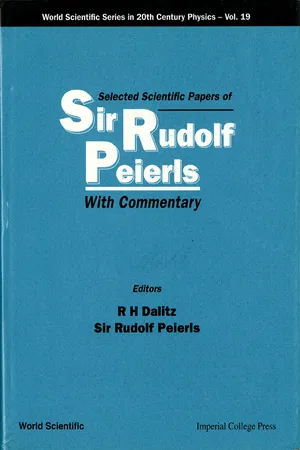
Selected Scientific Papers Of Sir Rudolf Peierls, With Commentary By The Author
(With Commentary)
- 832 pages
- English
- PDF
- Available on iOS & Android
Selected Scientific Papers Of Sir Rudolf Peierls, With Commentary By The Author
(With Commentary)
About This Book
This book is a collection of the major scientific papers of Sir Rudolf Peierls (1907-95), including the Peierls-Frisch Memoranda of 1940 on the feasibility, and the predicted human effects, of an atomic bomb made of uranium-235. His papers range widely in topic. They include much on the fundamentals of solid state physics, the thermal and electric conductivity of materials as a function of temperature T (especially T?0), the interpretation of the de Haas-van Alphen effect observed for a metal in a magnetic field, and the basics of transport theory. Many are on problems in statistical mechanics, including his constructive paper demonstrating the existence of a phase transition for Ising's model for a two-dimensional ferromagnet. In nuclear physics, they include the first calculations (with Bethe) on the photo-disintegration of the deuteron (made in response to a challenge by Chadwick), the Kapur-Peierls theory of resonance phenomena in nuclear reactions, the Bohr-Peierls-Placzek continuum model for complex nuclei (which first explained the narrow resonances observed for low energy neutrons incident on very heavy nuclei), and the Peierls-Thouless variational approach to collective phenomena in nuclei. Several of Peierls's wartime papers, now declassified, are here published for the first time.Brief commentaries on most of the papers in this book were added by Peierls, to indicate subsequent developments and their relationship with other work, or to correct errors found later on. A complete bibliography of his writings is given as an appendix.
Frequently asked questions
Information
Table of contents
- CONTENTS
- PREFACE
- CHRONOLOGY OF THE LIFE OF SIR RUDOLF ERNST PEIERLS
- Acknowledgements
- 1. On the Theory of Galvano-magnetic Effects
- 2. On the Theory of The Hall Effect
- 3. On the Existence of Stationary States
- 4. On the Kinetic Theory of Thermal Conduction in Crystals
- 5. On the Theory of Electric and Thermal Conductivity of Metals
- 6. Two Remarks on the Theory of Conductivity
- 3. QUANTUM ELECTRODYNAMICS IN CONFIGURATION SPACE
- 6. EXTENSION OF THE UNCERTAINTY PRINCIPLE TO RELATIVISTIC QUANTUM THEORY
- 9. On the Absorption Spectra of Solids
- 10. On the Theory of the Diamagnetism of Conduction Electrons
- 11. On the Theory of the Diamagnetism of Conduction Electrons II.Strong magnetic fields
- 12. Remarks on the Theory of Metals
- 13. On the Statistical Basis for the Electron Theory of Metals
- 14. Remarks on Transition Temperatures
- The "Neutrino"
- The Neutrino
- Quantum Theory of the Diplon
- The Scattering of Neutrons by Protons
- Statistical Error in Counting Experiments
- Statistical Theory of Superlattices with Unequal Concentrations of the Components
- NOTE ON THE DERIVATION OF THE EQUATION OF STATE FOR A DEGENERATE RELATIVISTIC GAS
- Magnetic Transition Curves of Supraconductors
- STATISTICAL THEORY OF ADSORPTION WITH INTERACTION BETWEEN THE ADSORBED ATOMS
- ON ISING'S MODEL OF FERROMAGNETISM
- Penetration into Potential Barriers in Several Dimensions
- Heat Conduction in Liquid Helium
- The dispersion formula for nuclear reactions
- On a Minimum Property of the Free Energy
- Nuclear Reactions in the Continuous Energy Region
- CRITICAL CONDITIONS IN NEUTRON MULTIPLICATION
- Interpretation of Beta-Disintegration Data
- THE SIZE OF A DISLOCATION
- The Frisch-Peierls Memorandum of 1940
- THE BOHR THEORY OF NUCLEAR REACTIONS
- Separation of Isotopes
- ON LORENTZ INVARIANCE IN THE QUANTUM THEORY
- The Equation of State of Air at High Temperatures
- EXPANSIONS IN TERMS OF SETS OF FUNCTIONS WITH COMPLEX EIGENVALUES
- The commutation laws of relativistic field theory
- The Polyneutron Theory of the Origin of the Elements
- Properties of Form Factors in Non-Local Theories
- A study of gauge-invariant non-local interactions
- Field equations in functional form
- NOTE ON THE VIBRATION SPECTRUM OF A CRYSTAL
- The coherent scattering of γ-rays by K electrons in heavy atoms I. Method
- Interpretation and properties of propagators
- The Peierls Transition
- The Collective Model of Nuclear Motion
- Two-Stage Model of Fermi Interactions
- Complex eigenvalues in scattering theory
- SELECTED TOPICS IN NUCLEAR THEORY
- Velocity-dependent Nuclear Forces
- VARIATIONAL APPROACH TO COLLECTIVE MOTION
- The Villars formalism for nuclear rotation
- Time reversal and the second law of thermodynamics
- The momentum of a light wave in a refracting medium
- Perturbation theory for projected states
- The force on a moving charge in an electron gas
- Perturbation theory for projected states II. Convergence criteria and a soluble model
- TEST OF PROJECTED PERTURBATION THEORY ON A SIMPLIFIED MODEL OF H2
- SOME SIMPLE REMARKS ON THE BASIS OF TRANSPORT THEORY
- The force in electromigration
- The momentum of light in a refracting medium
- RESONANT STATES AND THEIR USES
- LOCAL APPROXIMATION TO A NON-LOCAL POTENTIAL
- Model-Making in Physics
- The momentum of a sound pulse in a slightly dispersive medium
- Momentum and Pseudomomentum of Light and Sound
- OBSERVATIONS IN QUANTUM MECHANICS AND THE "COLLAPSE OF THE WAVE FUNCTION"
- Shape of Solitons in Classically Forbidden States: "Lorentz Expansion"
- In defence of "measurement"
- Broken symmetries
- Complete Bibliography for Sir Rudolf Peierls